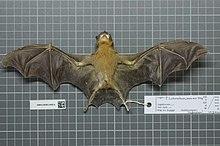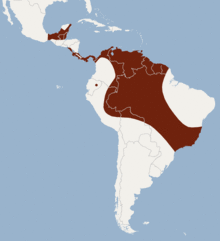| Yellow-throated big-eared bat | |
|---|---|
 | |
| Scientific classification | |
| Kingdom: | Animalia |
| Phylum: | Chordata |
| Class: | Mammalia |
| Order: | Chiroptera |
| Family: | Phyllostomidae |
| Genus: | Lampronycteris Sanborn, 1949 |
| Species: | L. brachyotis |
| Binomial name | |
| Lampronycteris brachyotis (Dobson, 1879) | |
 | |
| Synonyms | |
| |
The yellow-throated big-eared bat or orange-throated bat[2](Lampronycteris brachyotis) is a species of bat from South and Central America, where it ranges from southern Mexico to Brazil. It is monotypic within the genus Lampronycteris.[2] A frugivore and insectivore, it is found in lowland forest up to an elevation of 700 m.[1] Its activity is greatest in the first two hours after sunset, and peaks again after midnight.[1]
Description
The yellow-throated big-eared bat is characterized as a "medium-sized" leaf-nosed bat. Its ears are short and pointed, and its nose-leaf is relatively small. Its dorsal fur is dark brown or orange brown, and the ventral fur is orange or reddish-yellow. Individual bats weigh 9–15 g (0.32–0.53 oz) and have forearm lengths of 39–43 mm (1.5–1.7 in). The bat's dental formula is 2.1.2.32.1.3.3 for a total of 34 teeth.[3]
Biology and ecology
The yellow-throated big-eared bat is primarily an insectivore, but it will also consume fruit, nectar, and pollen. It is nocturnal, roosting in sheltered places during the day, such as caves, mines, hollow trees, and archaeological ruins. It generally roosts in small colonies consisting of 10 or fewer individuals, though a colony of 300 individuals was once documented in Mexico.[3]
Range and habitat
It is found in several countries in Central and South America.Its range includes: Belize, Brazil, Colombia, Costa Rica, French Guiana, Guatemala, Guyana, Mexico, Nicaragua, Panama, Peru, Suriname, Trinidad and Tobago, and Venezuela. It is generally found in lowland areas below 150 m (490 ft) above sea level, though it has been documented at up to 700 m (2,300 ft) above sea level.[1]
References
- ^ a b c d Solari, S. (2018). "Lampronycteris brachyotis". The IUCN Red List of Threatened Species. 2018: e.T13376A22131330. doi:10.2305/IUCN.UK.2018-2.RLTS.T13376A22131330.en.
- ^ a b Simmons, N.B. (2005). "Genus Lampronycteris". In Wilson, D.E.; Reeder, D.M (eds.). Mammal Species of the World: A Taxonomic and Geographic Reference (3rd ed.). Johns Hopkins University Press. p. 404. ISBN 978-0-8018-8221-0. OCLC 62265494.
- ^ a b Medellín, Rodrigo (2014). Ceballos, G. (ed.). Mammals of Mexico. JHU Press. pp. 683–684. ISBN 978-1421408439.
